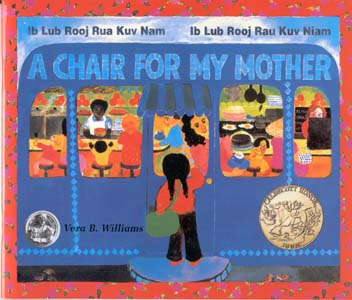Have you ever wanted to something so badly, that all your thoughts go into somehow attaining that special treat? You may have saved and saved your money for days, months, or years, until you had enough money to buy it. Teaching children how to save is a valuable lesson that they will use throughout their lifetime; saving teaches children hard work, diligence, and to appreciate their possessions.
Author and illustrator of A Chair for my Mother, Vera B. Williams, has created a story that captures the art of saving. The story revolves around a little girl, her mother, and her grandmother as they cope with a life tragedy. After shopping in town one day, the little girl and her mother come home to see a fire has engulfed their house and ruined all of their goods, including their sofa and chairs. Their neighbors all help furnish their new home, yet without anywhere to “take a load off my feet,” the little girl, her mother, and grandmother soon come to desire a big, comfy chair in their new home, that they can use to relax.
Yes, a chair: A wonderful, beautiful, fat, soft armchair. We will get one covered in velvet with roses all over it. We are going to get the best chair in the whole world.
Therefore, together the three save all of their money, putting their extra coins into a big glass jar. The little girl even goes to the Blue Tile Diner where her mother waitresses to earn some money to put in the jar.
I wash the salts and peppers and fill the ketchups One time I peeled all the onions for the onion soup. When I finished, Josephine says, “Good work, honey,” and pays me. And every time, I put half my money into the jar.
Her mother also puts her tips in the jar and her grandmother buys things on sale in order to add to the jar. When the jar became so heavy that the little girl can no longer lift it, she helps her mother wrap the coins and exchange them at the bank for dollar bills. With their money in hand, the three travel to the furniture store in search for the perfect chair. After hours of searching, they find the chair of their dreams. Finally, they bring the chair home and enjoy it each day!
Through the use of watercolors, Williams beautifully illustrates the pages of her story. Using bright imaginative pictures, the story comes alive with emotion, capturing every reader. Along with the illustrations on each page, Williams outlines the pictures with a corresponding painted border. The combination of text and illustrations make this book a truly great piece of literature.
Curriculum Connections
A Chair for My Mother serves as a great book to teach several different themes of economics. By reading about the little girl working at the Blue Tile Diner, children can learn that people work to earn money to buy things they want (Virginia SOL K.7). The distinct changes in the amount of coins in the glass jar as the story progresses, stresses that people save money for the future to purchase goods and services (Virginia SOL 1.9). This story is a great introductory piece of literature that can easily be relate to children’s daily lives. It may be a good idea to have students practice saving as a class; students can bring in their extra change each week in hopes to buy something that the whole class can enjoy!
Additional Resources
- Check out this lesson plan that re-enforces the importance of helping others. In this lesson, students will make a card for a family who have just arrived to the neighborhood. Just like the neighbors in A Chair for My Mother, students will learn to help others in a time of need.
- Use this site to help structure a discussion after reading this book. A list of comprehension questions as well as other concepts connected to economics are available.
- Looking for more books about savings? KidsEconBooks offers a list of kid-friendly books that teaches about economics.
Book: A Chair for my Mother
Author/Illustrator: Vera B. Williams
Publisher: HarperTrophy
Publication Date: 1984
Pages: 32 pages
Grades: K-3
ISBN: 0688040748

